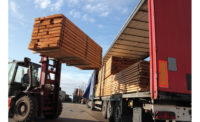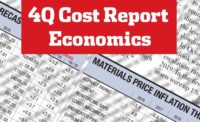Q4 Cost Report: Will More Copper Production Stabilize or Lower Prices?

As copper prices have escalated by nearly 20% in 2017, analyst forecasts differ on where they will head in 2018, although a big spike seems unlikely. This year’s increases continue an uptick that began in early 2016, when the price of copper dipped below $2 per pound. Through the final quarter of this year, prices have fluctuated at just above $3 per pound, marking a roughly 50% hike in two years.
Attilio Rivetti, vice president and director of preconstruction at Turner Construction, says several factors have driven the recent price increases. A strong construction market in 2016 and 2017 helped to drive demand, while supply was constrained, he says.
Copper-mine production dropped in 2017 by 2.7%, says the International Copper Study Group. It reported that supply disruptions in Chile and Indonesia and a lack of new projects and expansions contributed to the decline.
But ICSG forecasts that output from mine operations in Africa will improve in 2018, contributing to a rebound of 2.5%. Wall Street analysts for publicly owned construction-sector firms predict growth in copper and other commodity mining over the next several years.
With improved production, Rivetti expects at least a tempering of prices next year. “All of the stats I see say that copper will increase by a few more percentage points over the next several months,” Rivetti says. “But would I expect to see a steep spike in 2018? Probably not.”
John Mothersole, director of research for pricing and purchasing services at IHS Markit, says that, after a volatile couple of years, copper prices will pull back. “I don’t think prices are going much higher,” he says. “In fact, our forecast is that they will come back a bit next year.”
Mothersole notes that several factors drove recent demand. Overall, the global economy is “hitting on all cylinders,” with “no pockets of weakness right now.”
China Boosts Copper Demand
The International Copper Association sees continued strong demand for copper in China. The country’s most recent five-year plan, which began in 2016, forecasts a 15% increase in copper demand, the group says. ICA market analyst Colin Bennett sees the country’s push for renewable-energy and other innovative manufacturing that requires copper as a key catalyst.
Mothersole says the price of scrap metals, such as copper, has dropped. “These wide discounts have been a limiting factor on the rise in prices in the past couple of months,” he points out.
While China has been a major contributor to growth in recent years, Mothersole says much of that is artificial. Modest government stimulus packages in 2017 have breathed more life into China’s economy, but Mothersole doesn’t expect those efforts to continue.
“Stimulus helped China maintain industrial production at a good rate, but we don’t think that’s sustainable,” he says. “The government has the ability to continue to apply that stimulus, but odds are it will not.”
Mothersole says the stimulus has raised debt levels in China as extra capacity has been created in the industrial sector and property markets. “You have relatively high debt levels that can’t continue to rise,” he points out. “We think 2018 is the year that withdrawal of this stimulus begins to slow things down.”
In the meantime, major buyers of copper are uncertain about what purchasing path to follow.
Brian Antonsen, director of mechanical construction at McKinstry, says copper is the No. 1 commodity that the firm tracks. “We watch copper pretty religiously here,” he says. “It’s always on the agenda in our procurement meetings.”
After copper prices dropped to around $2 per pound from a recent peak of more than $4 per pound, Antonsen says the company took advantage of the opportunity. “We bundled our projects and pulled the approximate weight of copper we expect we’ll need,” he said. “We worked our supply chain to place the orders, while reserves were still high and prices were down, to avoid the risk we were about to see. We placed our bets, and it looks like it’s going to pay off.”
However, heading into 2018, Antonsen says the company is eyeing its next batch of work at an uncertain point in copper pricing. He says most of McKinstry’s clients prefer to own any escalation risk, but they still look to the contractor for guidance.
“We have several projects that will start construction in 2020, and we’re pricing them now,” Antonsen adds. “We have to consult owners on where those prices are likely to go, but a lot of owners aren’t willing to play the market and expend money on hard costs for pre-orders on a project that’s two years out.”


